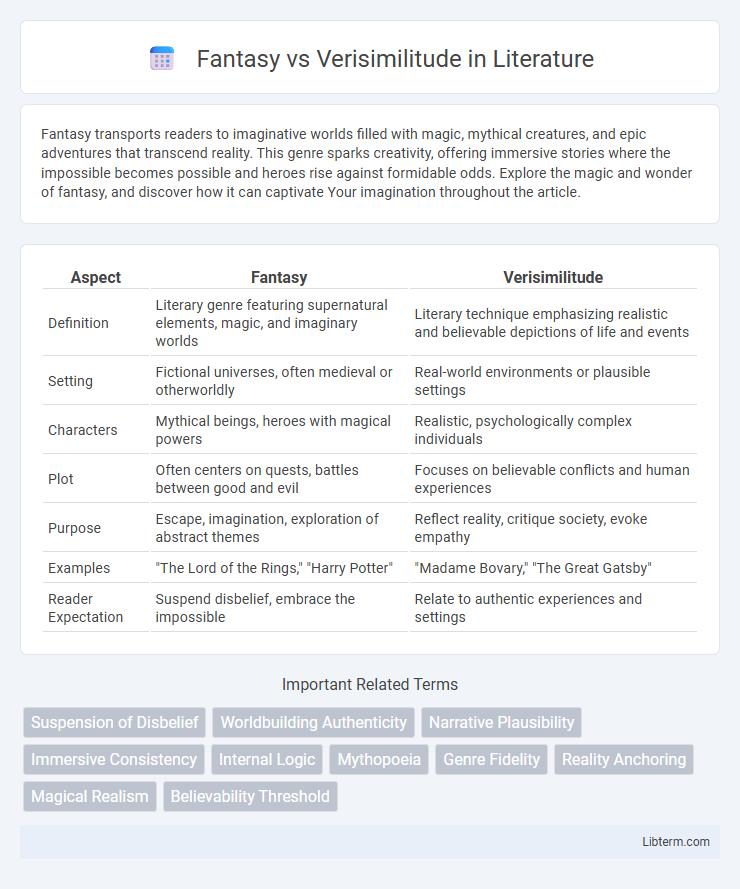Fantasy transports readers to imaginative worlds filled with magic, mythical creatures, and epic adventures that transcend reality. This genre sparks creativity, offering immersive stories where the impossible becomes possible and heroes rise against formidable odds. Explore the magic and wonder of fantasy, and discover how it can captivate Your imagination throughout the article.
Table of Comparison
| Aspect | Fantasy | Verisimilitude |
|---|---|---|
| Definition | Literary genre featuring supernatural elements, magic, and imaginary worlds | Literary technique emphasizing realistic and believable depictions of life and events |
| Setting | Fictional universes, often medieval or otherworldly | Real-world environments or plausible settings |
| Characters | Mythical beings, heroes with magical powers | Realistic, psychologically complex individuals |
| Plot | Often centers on quests, battles between good and evil | Focuses on believable conflicts and human experiences |
| Purpose | Escape, imagination, exploration of abstract themes | Reflect reality, critique society, evoke empathy |
| Examples | "The Lord of the Rings," "Harry Potter" | "Madame Bovary," "The Great Gatsby" |
| Reader Expectation | Suspend disbelief, embrace the impossible | Relate to authentic experiences and settings |
Understanding Fantasy and Verisimilitude
Fantasy creates immersive worlds characterized by imaginative elements like magic, mythical creatures, and supernatural events that challenge reality. Verisimilitude refers to the semblance of truth or realism in storytelling, ensuring that events and characters are believable within the narrative context. Understanding these concepts helps writers balance imaginative freedom with coherence, enhancing reader engagement by establishing plausible internal logic.
Defining Fantasy Elements in Storytelling
Fantasy elements in storytelling involve the inclusion of supernatural forces, magical creatures, or imaginative worlds that transcend reality's boundaries. These components create immersive experiences by introducing phenomena that defy scientific explanation, such as dragons, spells, or alternate universes. The deliberate incorporation of these fantastical aspects distinguishes fantasy narratives from genres grounded in verisimilitude, which emphasize lifelike and plausible events.
The Role of Verisimilitude in Fiction
Verisimilitude in fiction establishes a sense of believability that anchors fantastical elements in a relatable reality, enhancing reader engagement and suspension of disbelief. It involves consistent internal logic and plausible character motivations that reflect real-world experiences or emotions, even within imaginary settings. This balance allows authors to create immersive narratives that resonate emotionally while exploring imaginative themes.
Balancing Imagination and Believability
Balancing imagination and believability in fantasy storytelling requires integrating fantastical elements with consistent internal logic and relatable characters to maintain verisimilitude. Effective world-building hinges on rules that govern magic, societies, and creatures, ensuring these imaginative facets follow plausible patterns within the narrative framework. This synthesis heightens reader engagement by enabling suspension of disbelief while preserving the story's immersive authenticity.
World-Building: Creating Convincing Fantasies
World-building in fantasy requires crafting immersive universes with internally consistent rules that balance imaginative elements and verisimilitude to maintain reader engagement. Detailed landscapes, cultures, histories, and magical systems grounded in logical frameworks enhance believability while preserving the genre's creative freedom. Convincing fantasies rely on depth and coherence, allowing audiences to suspend disbelief and fully invest in the story's reality.
Character Development: Realism vs. Archetype
Character development in fantasy often relies on archetypes that symbolize universal themes, creating larger-than-life figures who embody specific traits or moral lessons. Verisimilitude demands realistic characters with complex motivations, flaws, and growth that reflect genuine human psychology and social dynamics. This contrast shapes narrative depth, as fantasy prioritizes symbolic resonance while verisimilitude emphasizes relatable human experience.
Reader Immersion: Suspension of Disbelief
Fantasy captivates reader immersion by constructing imaginative worlds that invite suspension of disbelief through consistent internal logic and rich detail. Verisimilitude enhances immersion by grounding narratives in believable characters, realistic settings, and plausible events, making the fictional experience relatable and convincing. Both approaches rely on coherent storytelling to maintain the reader's trust and emotional engagement throughout the narrative.
Common Pitfalls: When Fantasy Breaks Logic
Fantasy often falters when it disrupts internal logic, causing immersion breaks that alienate readers. Common pitfalls include inconsistent magic systems, arbitrary character abilities, and illogical world rules that undermine suspension of disbelief. Maintaining coherent, well-defined parameters ensures fantasy remains believable while preserving imaginative freedom.
Influential Works: Fantasy with Realism
Influential works blending fantasy with verisimilitude, such as Gabriel Garcia Marquez's "One Hundred Years of Solitude" and Susanna Clarke's "Jonathan Strange & Mr Norrell," ground magical elements in richly detailed, believable settings, enhancing narrative immersion. These stories use realistic historical contexts and complex characters to make fantastical events resonate authentically with readers. The seamless fusion of fantasy and realism creates a compelling tension that challenges perceptions of reality and encourages deeper engagement with the text.
Choosing Between Fantasy and Verisimilitude
Choosing between fantasy and verisimilitude hinges on the desired narrative impact and audience engagement. Fantasy emphasizes imaginative world-building, magical elements, and escapism, captivating readers through creativity and wonder. Verisimilitude prioritizes realistic characters, plausible events, and logical consistency, enhancing immersion by mirroring real-life experiences and emphasizing authenticity.
Fantasy Infographic

 libterm.com
libterm.com